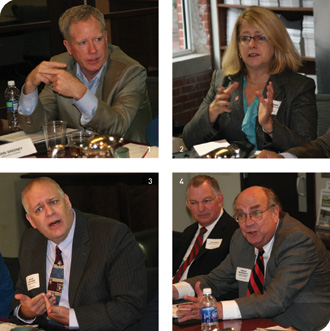
1. John Sweeney of the KU School of Business said research done there is targeted at top journals, not business utility. | 2. Kay Henry cited the need to teach critical-thinking skills at the Olin School. | 3. Myles Gartland said a long Jesuit tradition helps to differentiate Rockhurst. | 4. Southeast Missouri State’s Gerald McDougall talked about balancing instruction and research.
“Relevancy is a slippery subject,” said Gerald McDougall. “Relevant today, or relevant tomorrow?” At Southeast Missouri, research is an important component of faculty members’ responsibilities. “I want my faculty members to be relevant in their understanding of business practices and conceptual thoughts today,” said McDougall, “and I want them to have a scholarly program so that they maintain that connection.”
Teng-Kee Tan observed that research relevance is a dilemma that academic deans have long confronted. The Bloch School promotes what Teng-Kee calls “use-inspired research.” Faculty members are encouraged to use their research skills to apply to subjects that are use-inspired and that have some application in the real world. Until the use-inspired model of engaged scholarship is widely accepted, however, the Bloch School relies on team teaching to combine research talent with real-world applicability.
Although Webster University is not a research institution, Carolyn Cottrell, regional director for the school’s Kansas City operations, observed that a few of its professors in this region had turned their attention to what is called problem-based learning—that is, solving real management and marketing problems for real institutions.
Market Differentiation
In an era when the MBA is becoming increasingly commoditized and the competition to recruit MBA students increasingly intense, participants were asked what their schools did to distinguish themselves in the marketplace.
Michael Muoghalu, MBA program director at Pittsburg State University’s Kelce School of Business, said that his school experimented with online and extension programming, but realized what students there preferred was a traditional, campus-based MBA program.
Kay Henry, associate dean and director of the Executive MBA program for Washington University’s Olin Business School, took a more abstract tack. She sees as her program’s strength its focus on teaching students “to think critically around complex issues,” especially in regard to global and emerging markets. Positioning is critical for Washington University as it started its executive MBA program in Kansas City just two years ago.
“We try to differentiate based on our mission,” said Rockhurst’s Myles Gartland. He was referring specifically to the school’s Jesuit tradition, a tradition that, as a positive side effect, has spawned a worldwide network of potential employers.
John Sweeney cited three dimensions in the University of Kansas’s positioning strategy. For one, KU strives to recruit the best students in the region, which should lead to the best graduates as well. That presumes, of course, a second dimension, namely the right faculty. The third is a proven placement record. “This is a cycle that feeds on itself,” said Sweeney, “but all the inputs have to be working together and you have to have high quality at all levels.”
Placement is a selling point for Keller. As Don Weiss pointed out, the school has a strong career-services department that offers help for alumni. It is also part of a national network with more than 100 locations.
As its point of differentiation, Benedictine Colleger prefers to hire faculty with industry experience, ideally with Ph.D.s, as well. “Students considering an MBA program look at the faculty as their primary point of decision-making,” argued Dave Geenens of Benedictine. “So I think that’s an absolutely critical issue.”
The Economy
Those gathered were asked how the economy had affected their student recruitment and their planning for the future.
Gerald McDougall has found more undergraduate students are going immediately into the MBA program because the opportunity cost is less. Similarly, he observed, enrollment growth has occurred on almost all Missouri public campuses despite a decline in high school graduates. For many, education delays a confrontation with the job market.